Sunflower
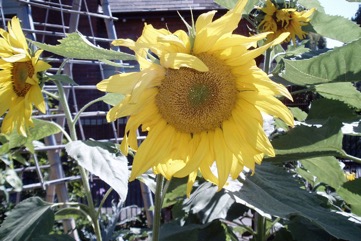
A temperate plant. It suits the highlands of the tropics and can stand a light frost. It needs a well drained soil. It prefers a rich soil. It is drought and frost resistant. Sunflowers grow from the equator to 55°N latitude. They do not suit the wet tropics. They cannot tolerate very acid soils. It can grow in arid places. In Hobart Botanical gardens. In Nepal it grows up to 600 m altitude. It suits hardiness zones 4-11. In Yunnan.
Also known as:
Aditya-bhaktichettu, Bunga matahari, Chhouk rath, Flor del sol, Girasol guacho, Gulberoj, Intipangara, Intitica, Maravilla, Mirasol, Nanala, Navadna sončnica, Negya, Surajamakha, Surjomukhi bij, Suryakanti, Suryamykhi, Suryaphul, Tournesol, Tshiteaduvha, Xiang ri kui
Synonyms
- Helianthus annuus subsp. lenticularis (Cockerell) Cockerell
- Helianthus annuus var. lenticularis Cockerell
- Helianthus annuus var. macrocarpus (DC.) Cockerell
- Helianthus lenticularis Douglas
Edible Portion
- Seeds, Flowers, Spice, Oil, Root - tea
Where does Sunflower grow?
Found in: Africa, Angola, Argentina, Asia, Australia, Bangladesh, Botswana, Britain, Bulgaria, Burkina Faso, Burundi, Cambodia, Cameroon, Canada, Caucasus, Central Africa, Central America, Central Asia, Chile, China, Congo DR, Costa Rica, Cuba, Dominican Republic, East Africa, Eritrea, Ethiopia, Europe, Fiji, Finland, France, Gambia, Georgia, Germany, Ghana, Guinea, Guinée, Guyana, Haiti, Hawaii, Himalayas, Hungary, India, Indochina, Jamaica, Kazakhstan, Kenya, Korea, Macedonia, Malawi, Mauritania, Mediterranean, Mexico, Moldova, Mongolia, Morocco, Mozambique, Myanmar, Namibia, Nepal, New Zealand, Niger, Nigeria, North Africa, North America, Pacific, Pakistan, Papua New Guinea, PNG, Peru, Philippines, Puerto Rico, Romania, Russia, Rwanda, Scandinavia, SE Asia, Senegal, Serbia, Seychelles, Sierra Leone, Slovenia, Somalia, South Africa, Southern Africa, South America, South Sudan, Spain, Sri Lanka, Sudan, Switzerland, Tajikistan, Tanzania, Tasmania, Thailand, Turkey, Uganda, Ukraine, Uruguay, United States, West Africa, West Indies, Yugoslavia, Zambia, Zimbabwe
Notes: Almost all Helianthus (70 species) in N and S America are edible. Elias, T.S. & Dykeman P.A., 1990, Edible Wild Plants. A North American Field guide. Sterling, New York p 156
Status: A major crop for oil seed. The seeds contain 40% oil.
Growing Sunflower
Cultivation: Plants are grown from seed. Only well filled seed should be planted. It is easy to save your own seed. Dry seed stores well. It will grow on most soils. A plant spacing of 1 m by 0.5 m is suitable. Seed are sown at a depth of 2-4 cm. At maturity heads are collected by hand and dried then threshed.
Edible Uses: An edible oil is extracted from the seeds and used for cooking. Sometimes seeds are eaten raw or roasted. The seeds can be ground into a meal for using in bread and cakes. They are also dried, roasted and ground and used as a coffee substitute. The seeds are boiled with water and honey to make a drink. The germinated seeds are fermented into a yogurt or cheese. The young flower buds are steamed and served like globe artichokes.
Production: Time to maturity is usually 4-5 months. Seeds are ready to eat when the flower starts to wither.
Nutrition Info
per 100g edible portion| Edible Part | Energy (kcal) | Protein (g) | Iron (mg) | Vitamin A (ug) | Vitamin c (mg) | Zinc (mg) | % Water |
|---|---|---|---|---|---|---|---|
| Seed | 571 | 22.8 | 6.8 | 5 | 1.4 | 5.1 | 5.4 |
Sunflower Photos

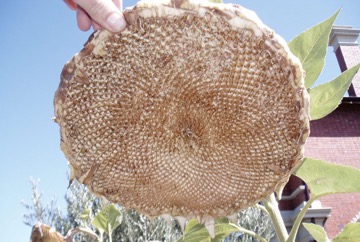
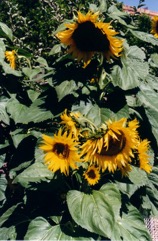
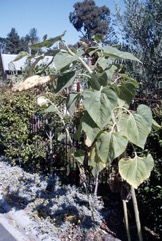
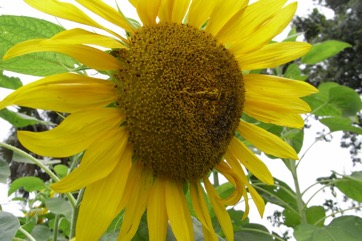
References
Ambasta, S.P. (Ed.), 2000, The Useful Plants of India. CSIR India. p 259
Anderson, E. F., 1993, Plants and people of the Golden Triangle. Dioscorides Press. p 212
Anderson, M. K., 2012, Edible Seeds and Grains of California Tribes and the Klamath Tribe of Oregon in the Phoebe Apperson Hearst Museum of Anthropology Collections, University of California, Berkeley. USDA p 50
Bernholt, H. et al, 2009, Plant species richness and diversity in urban and peri-urban gardens of Niamey, Niger. Agroforestry Systems 77:159-179
Bianchini, F., Corbetta, F., and Pistoia, M., 1975, Fruits of the Earth. Cassell. p 238
Blamey, M and Grey-Wilson, C., 2005, Wild flowers of the Mediterranean. A & C Black London. p 440
Bodkin, F., 1991, Encyclopedia Botanica. Cornstalk publishing, p 544
Borrell, O.W., 1989, An Annotated Checklist of the Flora of Kairiru Island, New Guinea. Marcellin College, Victoria Australia. p 63
Bremness, L., 1994, Herbs. Collins Eyewitness Handbooks. Harper Collins. p 252
Brickell, C. (Ed.), 1999, The Royal Horticultural Society A-Z Encyclopedia of Garden Plants. Convent Garden Books. p 504
Brouk, B., 1975, Plants Consumed by Man. Academic Press, London. p 223
Brown, D., 2002, The Royal Horticultural Society encyclopedia of Herbs and their uses. DK Books. p 232
Burkill, H. M., 1985, The useful plants of west tropical Africa, Vol. 4. Kew.
Burkill, I.H., 1966, A Dictionary of the Economic Products of the Malay Peninsula. Ministry of Agriculture and Cooperatives, Kuala Lumpur, Malaysia. Vol 1 (A-H) p 1150
Burnie, G.(Ed.), 2003, Annuals and Bulbs. The Gardener's Handbooks. Fog City Press. p 167
Bussman, R. W., et al, 2016, A comparative ethnobotany of Khevsureti, Samtskhe-Javakheti, Tusheti, Svaneti, and Racha-Lechkhumi, Republic of Georgia (Sakartvelo), Caucasus. Journal of Ethnobiology and Ethnomedicine (2016) 12:4
Bussman, R. W. et al, 2017, Ethnobotany of Samtskhe-Javakheti, Sakartvelo (Republic of Georgia), Caucasus. Indian Journal of Traditional Knowledge Vol. 16(1) pp 7-24
Cribb, A.B. & J.W., 1976, Wild Food in Australia, Fontana. p 97, 162, 178
Cundall, P., (ed.), 2004, Gardening Australia: flora: the gardener's bible. ABC Books. p 684
Elias, T.S. & Dykeman P.A., 1990, Edible Wild Plants. A North American Field guide. Sterling, New York p 156
Esperanca, M. J., 1988. Surviving in the wild. A glance at the wild plants and their uses. Vol. 2. p 249
Facciola, S., 1998, Cornucopia 2: a Source Book of Edible Plants. Kampong Publications, p 39
Fowler, D. G., 2007, Zambian Plants: Their Vernacular Names and Uses. Kew. p 12
French, B.R., 1986, Food Plants of Papua New Guinea, A Compendium. Asia Pacific Science Foundation p 353
French, B.R., 2010, Food Plants of Solomon Islands. A Compendium. Food Plants International Inc. p 336
Gouldstone, S., 1983, Growing your own Food-bearing Plants in Australia. Macmillan p 180
Hedrick, U.P., 1919, (Ed.), Sturtevant's edible plants of the world. p 337
Heiser,C.B., 1979, Sunflowers, in Simmonds N.W.,(ed), Crop Plant Evolution. Longmans. London. p 36
Hermandez Bermejo, J.E., and Leon, J. (Eds.), 1994, Neglected Crops. 1492 from a different perspective. FAO Plant Production and Protection Series No 26. FAO, Rome. p18
Hussey, B.M.J., Keighery, G.J., Cousens, R.D., Dodd, J., Lloyd, S.G., 1997, Western Weeds. A guide to the weeds of Western Australia. Plant Protection Society of Western Australia. p 98
Hu, Shiu-ying, 2005, Food Plants of China. The Chinese University Press. p 734
Huxley, A. (Ed.), 1977, The Encyclopedia of the Plant Kingdom. Chartweil Books. p 155
Jardin, C., 1970, List of Foods Used In Africa, FAO Nutrition Information Document Series No 2.p 43
Kiple, K.F. & Ornelas, K.C., (eds), 2000, The Cambridge World History of Food. CUP p 434, 1861
Latham, P., 2004, Useful Plants of Bas-Congo province. Salvation Army & DFID p 146
Lazarides, M. & Hince, B., 1993, Handbook of Economic Plants of Australia, CSIRO. p 129
Lim, T. K., 2015, Edible Medicinal and Non Medicinal Plants. Volume 9, Modified Stems, Roots, Bulbs. Springer p 45
Liu, Yi-tao, & Long, Chun-Lin, 2002, Studies on Edible Flowers Consumed by Ethnic Groups in Yunnan. Acta Botanica Yunnanica. 24(1):41-56
Loughmiller, C & L., 1985, Texas Wildflowers. A Field Guide. University of Texas, Austin. p 62
Low, T., 1992, Bush Tucker. Australia’s Wild Food Harvest. Angus & Robertson. p 30
Lyle, S., 2006, Discovering fruit and nuts. Land Links. p 236
MacKinnon, A., et al, 2009, Edible & Medicinal Plants of Canada. Lone Pine. p 352
Magwede, K., van Wyk, B.-E., & van Wyk, A. E., 2019, An inventory of Vhavenḓa useful plants. South African Journal of Botany 122 (2019) 57–89
Malezas Comestibles del Cono Sur, INTA, 2009, Buernos Aires
Manandhar, N.P., 2002, Plants and People of Nepal. Timber Press. Portland, Oregon. p 256
Menninger, E.A., 1977, Edible Nuts of the World. Horticultural Books. Florida p 102
Miguel, E., et al, 1989, A checklist of the cultivated plants of Cuba. Kulturpflanze 37. 1989, 211-357
Moerman, D. F., 2010, Native American Ethnobotany. Timber Press. p 257
Mukemre, M., et al, 2016, Survey of wild food plants for human consumption in villages of Catak, (Van-Turkey), Indian Journal of Traditional Knowledge. Vol. 15(2) pp. 183-191
Omawale, 1973, Guyana's edible plants. Guyana University, Georgetown p 60
Paczkowska, G. & Chapman, A.R., 2000, The Western Australian Flora. A Descriptive Catalogue. Western Australian Herbarium. p 164
Peekel, P.G., 1984, (Translation E.E.Henty), Flora of the Bismarck Archipelago for Naturalists, Division of Botany, Lae, PNG. p 563,
Phon, P., 2000, Plants used in Cambodia. © Pauline Dy Phon, Phnom Penh, Cambodia. p 336
Plants for a Future database, The Field, Penpol, Lostwithiel, Cornwall, PL22 0NG, UK. http://www.scs.leeds.ac.uk/pfaf/
Plants of Haiti Smithsonian Institute http://botany.si.edu
Purseglove, J.W., 1968, Tropical Crops Dicotyledons, Longmans. p 68
Royal Botanic Gardens, Kew (1999). Survey of Economic Plants for Arid and Semi-Arid Lands (SEPASAL) database. Published on the Internet; http://www.rbgkew.org.uk/ceb/sepasal/internet [Accessed 11th April 2011]
Ruiters-Welcome, A. K., 2019, Food plants of southern Africa. Ph.D. thesis. Univ. of Johannesburg p 34
Saunders, C.F., 1948, Edible and Useful Wild Plants. Dover. New York. p 49
Skinner, G. & Brown, C., 1981, Simply Living. A gatherer's guide to New Zealand's fields, forests and shores. Reed. p 50
Sp. pl. 2:904. 1753
Staples, G.W. and Herbst, D.R., 2005, A tropical Garden Flora. Bishop Museum Press, Honolulu, Hawaii. p 161
USDA, ARS, National Genetic Resources Program. Germplasm Resources Information Network - (GRIN). [Online Database] National Germplasm Resources Laboratory, Beltsville, Maryland. Available: www.ars-grin.gov/cgi-bin/npgs/html/econ.pl (10 April 2000)
van der Vossen, H.A.M. & Fagbayide, J.A., 2007. Helianthus annuus L. [Internet] Record from Protabase. van der Vossen, H.A.M. & Mkamilo, G.S. (Editors). PROTA (Plant Resources of Tropical Africa), Wageningen, Netherlands. < http://database.prota.org/search.htm>. Accessed 16 October 2009.
van Wyk, B., 2005, Food Plants of the World. An illustrated guide. Timber press. p 206
van Wyk, Be, & Gericke, N., 2007, People's plants. A Guide to Useful Plants of Southern Africa. Briza. p 22
Vickery, M.L. and Vickery, B., 1979, Plant Products of Tropical Africa, Macmillan. p 30
Wickens, G.E., 1995, Edible Nuts. FAO Non-wood forest products. FAO, Rome. p 18, 117
Williamson, J., 2005, Useful Plants of Malawi. 3rd. Edition. Mdadzi Book Trust. p 129
World Checklist of Useful Plant Species 2020. Royal Botanic Gardens, Kew
Zaldivar, M. E., et al, 2002, Species Diversity of Edible Plants Grown in Homegardens of Chibehan Amerindians from Costa Rica. Human Ecology, Vol. 30, No. 3, pp. 301-316